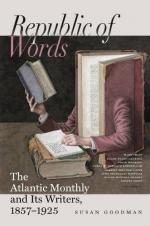freshness, and the thrill and exhilaration of conscious
activity. Her imagination was roused by the revival
of ancient and now new learning, by the stories of
travellers, by the gains of commerce, by the excitements
of religion and the alarms of superstition. She
was boastful, jealous, quarrelsome, lavish, magnificent,
full of fickleness,—exhibiting on all sides
the exuberance, the magnanimity, the folly of youth.
After the long winter of the Dark Ages, spring had
come, and the earth was renewing its beauty.
And above all other cities in these days Florence was
full of the pride of life. Civil brawls had not
yet reduced her to become an easy prey for foreign
conquerors. She was famous for wealth, and her
spirit had risen with prosperity. Many years before,
one of the Provencal troubadours, writing to his friend
in verse, had said,—“Friend Gaucelm,
if you go to Tuscany, seek a shelter in the noble
city of the Florentines, which is named Florence.
There all true valor is found; there joy and song
and love are perfect and adorned.” And
if this were true in the earlier years of the thirteenth
century, it was still truer of its close; for much
of early simplicity and purity of manners had disappeared
before the increasing luxury (le morbidezze d’
Egitto, as Boccaccio terms it) and the gathered
wealth of the city,—so that gayety and
song more than ever abounded. “It is to
be noted,” says Giovanni Villani, writing of
this time, “it is to be noted that Florence
and her citizens were never in a happier condition.”
The chroniclers tell of constant festivals and celebrations.
“In the year 1283, in the month of June, at the
feast of St. John, the city of Florence being in a
happy and good state of repose,—a tranquil
and peaceable state, excellent for merchants and artificers,—there
was formed a company of a thousand men or more, all
clothed in white dresses, with a leader called the
Lord of Love, who devoted themselves to games and
sports and dancing, going through the city with trumpets
and other instruments of joy and gladness, and feasting
often together. And this court lasted for two
months, and was the most noble and famous that ever
was in Florence or in all Tuscany, and many gentlemen
came to it, and many rhymers,[4] and all were welcomed
and honorably cared for.” Every year, the
summer was opened with May and June festivals.
Florence was rejoicing in abundance and beauty.[5]
Nor was it only in passing gayeties that the cheerful
and liberal temper of the people was displayed.
The many great works of Art which were begun and carried on to completion at this time show with what large spirit the whole city was inspired, and under what strong influences of public feeling the early life of Dante was led. Civil liberty and strength were producing their legitimate results. Little republic as she was, Florence was great enough for great undertakings. Never was there such a noble activity within the narrow compass of her walls as from about 1265, when Dante




